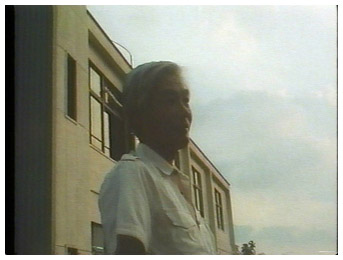


 |


launch interview with Hiroyuki Oki
Hiroyuki Oki trained as an architect before deciding to study film at the Image Forum Institute of the Moving Image in Tokyo, and his interest in architecture provided a complement to his work as an "experimental docu-mentarist." In the artist's eyes, architecture and film are but two different ways to articulate social spaces and experiences: films generating space, architecture generating images.
In 1991, Oki moved from Tokyo to the southern province of Kochi, which has become his home base and the location of his films. His films, and specifically Heaven-6-Box (1995), are timeless ballads showing sensitive ties to local peoples and local environments. Oki follows a seemingly structureless methodology based on chance meetings, trying to capture situations not as a witness but from within a community. His camera is always at touching distance from his object, poetically at skin level. In depicting microevents and everyday gestures--the rhythm of life--the goal is to synthesize a "universal" architecture of the world. Oki is capturing the space, the air between events, objects, architecture, and people--invisible space where one could invent a relationship. His films are about a state of immanence, the condition of being within the limits of all possible experience, including the sexual. Often labeled a gay filmmaker, Oki is reluctant to embrace such an identification and would prefer to define his works as "queer ambient movies." Sexuality and gender are used in his films as opportunities for observing just how capable civilization is of accepting differences and alternatives.
Formally, Oki's films seem driven by his personal reaction to moments of epiphany, mapping his own feelings as much as the events in front of the eyes. Light, the very specific light of Kochi, is often a calculated element in the work, used for metaphoric, if not religious, effect. Every accident, every imperfection in the filming, becomes part of the end result and contributes to the impression that Oki takes it all in without judgment, and that it is his camera that allows him to participate in the life around him. The timing of the films--the duration of the images--and the sound tracks contribute to a contemplative tone. The editing is often done during filming, not in postproduction. Oki's work is fully informed, even if obliquely, by a history of moving-image practices that includes Jonas Mekas' claim for regionalism, Stan Brakhage's experimentation with light and celluloid, and Suzuki Shiroyasu's predilection for the diary format.
Oki is engaged in various other activities such as writing, drawing, veejay events, and performances. His fil-mography includes the three-hour-long thesis film The Film of Buddy Matsumae (1989); Swimming Prohibited (1990), which won the Special Juror Prize at the 1990 Image Forum Festival; Tarch Trip (1993); and Heaven-6-Box (1995), winner of the NETPAC Prize at the 1995 Berlin International Film Festival. He directed his first 35mm fiction film, I Like You, I Like You Very Much, in 1994.
Oki had a solo exhibition at Ota Fine Arts, Tokyo, Japan, in 2001, and has been featured in a number of group shows in Japan, including Articulate Voice: From the Age of New Imagery Expansions, Yokohama Civic Art Gallery (2001); Game Over, Watari Museum of Contemporary Art, Tokyo (2000); and Temperature of Time, Setagaya Art Museum (1999).
--Philippe Vergne











